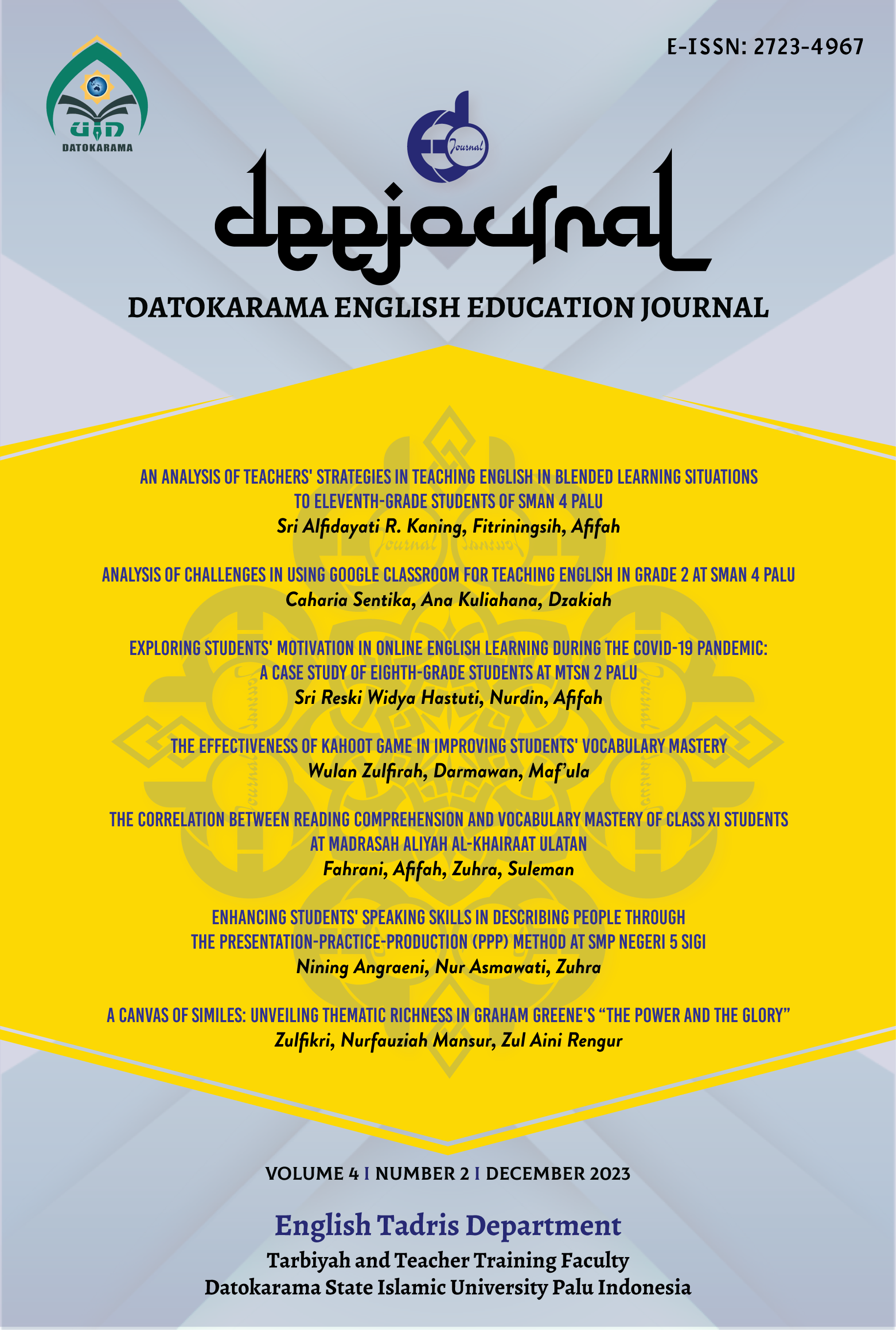An Analysis of Teachers' Strategies in Teaching English in Blended Learning Situations to Eleventh-Grade Students of SMAN 4 Palu
DOI:
https://doi.org/10.24239/dee.v4i2.74Keywords:
Strategy, English, Blended learningAbstract
This research discussed an Analysis of Teachers’ Strategies in Teaching English in Blended Learning Situation at Eleventh Grade Students of SMAN 4 Palu. The research question of this research are: (1) what strategy do teachers use in teaching English in a blended learning situation to eleventh-grade students of SMAN 4 Palu? (2) how is the implementation of the strategies in teaching English in blended learning situations to eleventh-grade students of SMAN 4 Palu?. In this research, the researcher used qualitative descriptive research, with case study research type. Technique of data collection through (1) observation, (2) interview, (3) questionnaire, and (4) documentation. Technique of data analysis are data collection, data reduction, data display, and conclusion. Checking data validity was conducted with (1) credibility, (2) transferability, (3) dependability, and (4) confirmability (Objectivity). The results of this research showed that the strategy that teachers use in teaching English in blended learning situations in class XI is vocabulary building, cooperative learning, and students chosen text. Based on the results of the questionnaire given to students, by using the Likert scale technique, about 77% category agree or good. It means the students’ response to the teacher in teaching English in blended learning situation at eleventh grade students of SMAN 4 Palu is good and able to help students in learning English. Students like the way of teaching of the English teachers.
References
Darmansyah, Strategi Pembelajaran Menyenangkan Dengan Humor (3th Edition; Jakarta: Bumi Aksara, 2012).
Hamidah, Nur. “Teacher’s Strategy in Teaching English for Deaf Students at SLB Manungal Slawi-Tegal” Jurnal Dialektika Program Studi Pendidikan Bahasa Inggris, vol. 9 no. 1 (March 2021-August 2021).
Hardani, et al., eds., Metode Penelitian Kualitatif & Kuantitatif (Yogyakarta: Pustaka Ilmu Group, 2020).
Johar, Rahmah. and Latifah Hanum, Strategi Belajar Mengajar: Untuk Menjadi Guru yang Profesiona (Banda Aceh: Syiah Kuala University Press, 2019).
Keputusan Bersama Menteri Pendidikan dan Kebudayaan, Menteri Agama, Menteri Kesehatan, dan Menteri dalam Negeri Republik Indonesia, Tentang Panduan Penyelenggaraan Pembelajaran di Masa Pandemi CORONA VIRUS DISEASE 2019 (COVID-19).
Miles, Matthew B. and A. Michael Huberman, translated by Tjetjep Rohendi Rohidi,
Qualitative Data Analysis (Jakarta: Ul-Press, 1992).
Moleong, Lexy J. Metode Penelitian Kualitatif (36th Edition; Bandung: PT. Remaja Rosdakarya Offset, 2017).
Nation, I. S. P. Learning Vocabulary in Another Language (Cambridge: Cambridge Applied Linguistics, 2000).
Romiszowski, Designing Instructional System (New York: Nicholas Publishing, 1981). Sugiyono, Metode Penelitian Bisnis (Pendekatan Kuantitatif, Kualitatif, R & D) (Bandung:
Alfabeta, 2008).
Sugiyono, Metode Penelitian Kuantitatif, Kualitatif dan R & D (19th Edition; Bandung: Alfabeta, 2013).
Sugiyono, Metode Penelitian Kuantitatif, Kualitatif Dan R & D (19th Edition; Bandung: Alfabeta, 2013).
Sukmawati, Alfiah Kharisma. “Pembelajaran Kosakata Bahasa Inggris Menggunakan Metode Modelling The Way Pada Kelas IV MI Ma’arif Polorejo Kabupaten Ponorogo” (Jurusan Tarbiyah, IAIN Ponorogo, Ponorogo, 2020).
Sumandiyar, Adi. et al., eds., “The Effectiviness of Hybrid Learning as Instructional Media
Amid The Covid-19 Pandemic” Jurnal Studi Komunikasi, vol. 5 no. 3
(November 2021).
Wahyuni, Ayu Sri. “Penerapan Model Hybrid Learning dalam PTM Terbatas untuk Meningkatkan Motivasi dan Hasil Belajar Siswa” Indonesian Journal of Educational Development, vol. 2 no. 3 (November 2021).
WE Right. Foundations for Teaching English Language Learners. academia.edu
Downloads
Published
How to Cite
Issue
Section
License
Copyright (c) 2023 Sri Alfidayati R. Kaning, Fitriningsih Fitriningsih, Afifah Afifah

This work is licensed under a Creative Commons Attribution-NonCommercial 4.0 International License.


















